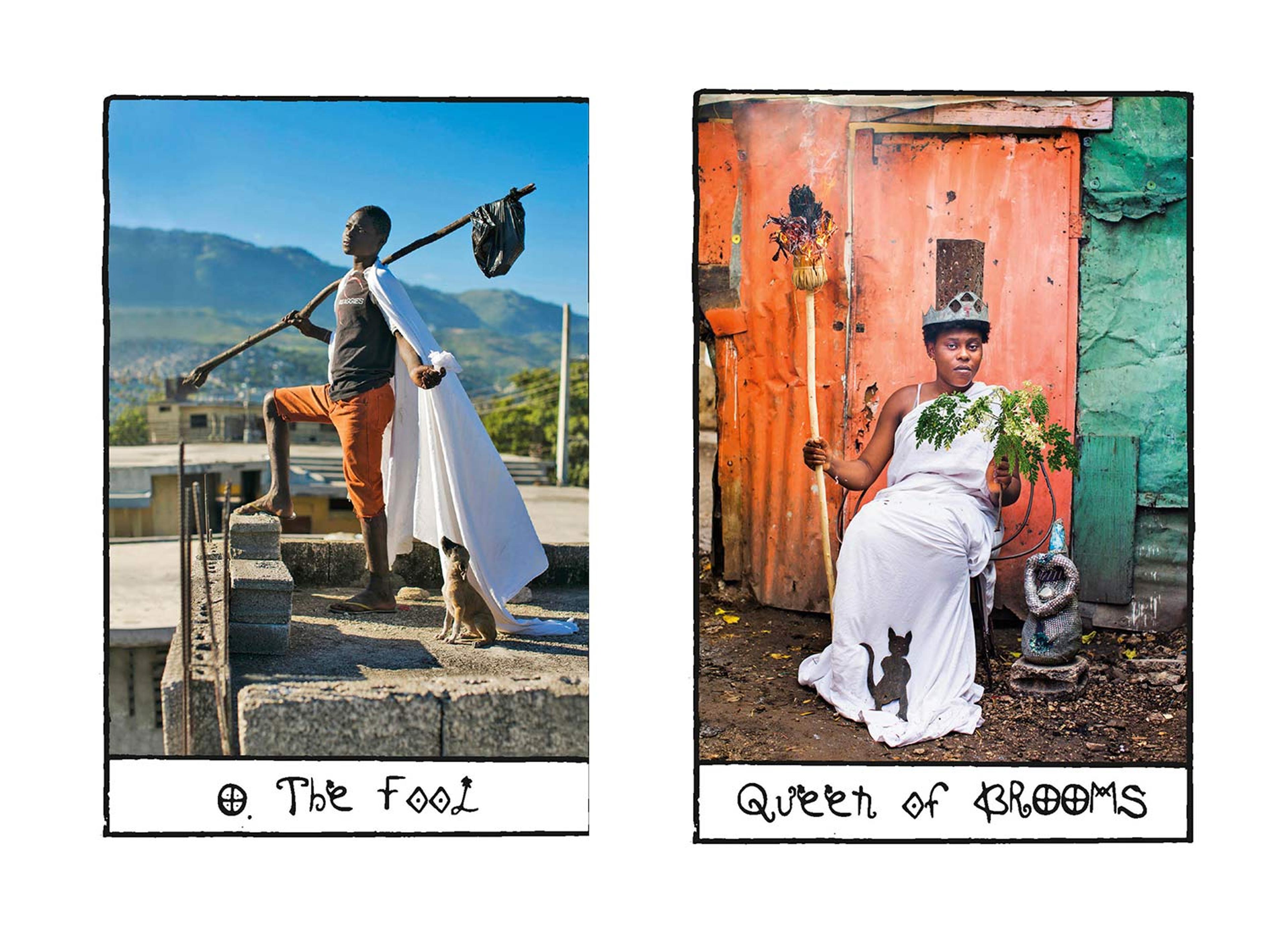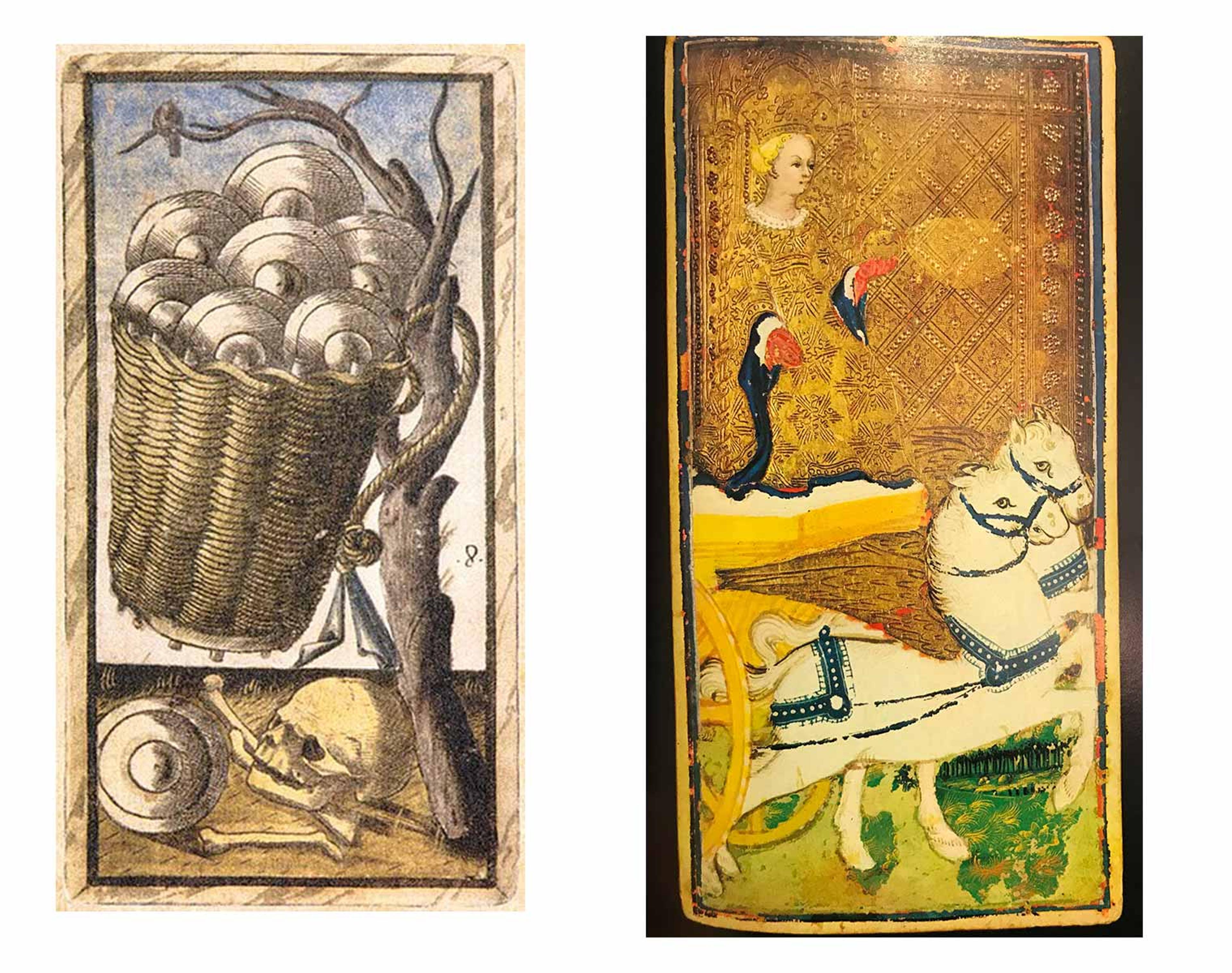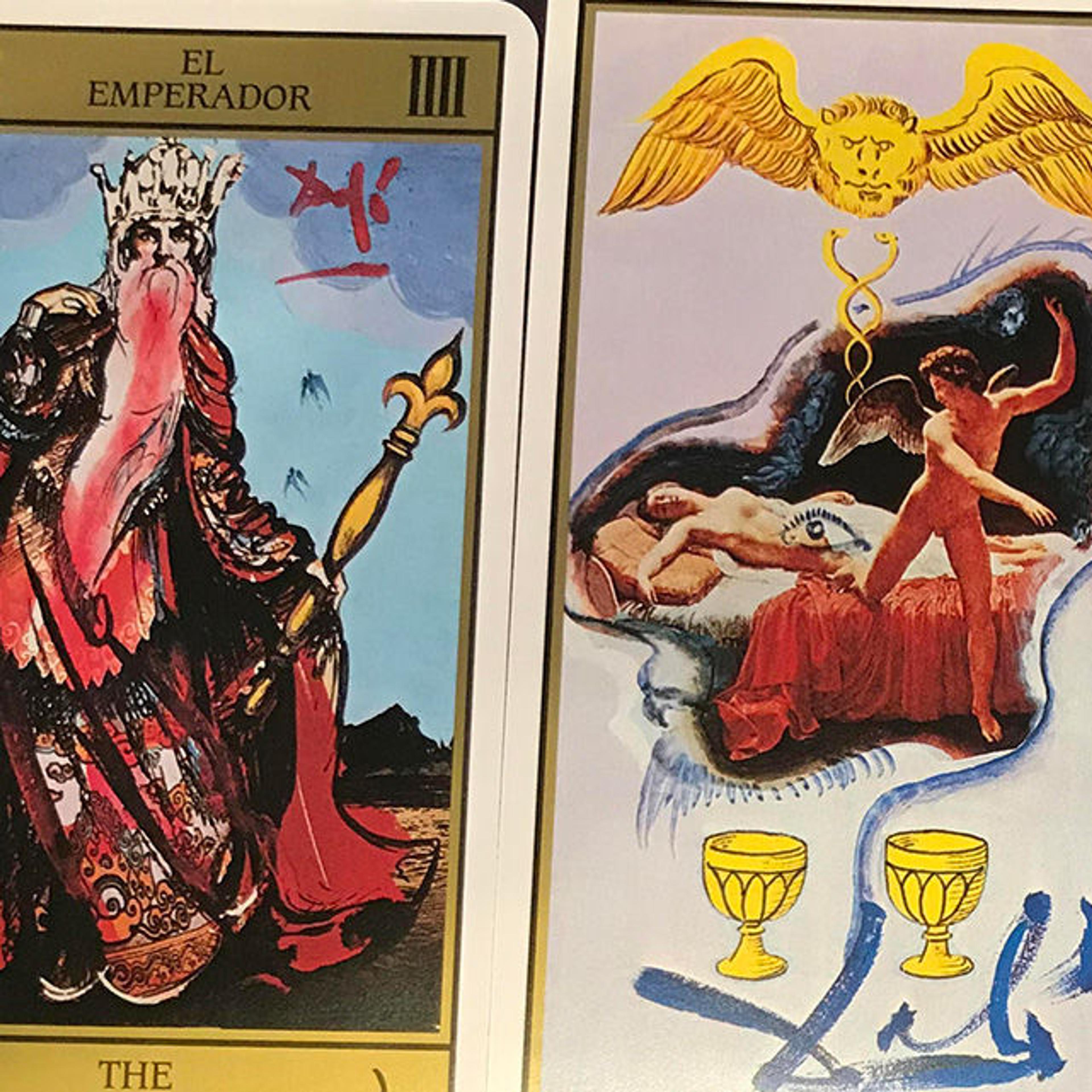If one thing can be said for the past year, it’s that it was a highly unpredictable one. Sometimes a future full of ambiguity can add an air of excitement to life, but the uncertainty that the pandemic offered us has been of the more stressful variety.
In this era of uncertainty, I’ve been turning again and again to the age-old practice of reading tarot cards. Although the mere mention of the tarot may elicit eye rolls in some, gazing at the cards and their iconic, archetypal images, gave me great clarity in an uneasy time, if not a clear sign of future developments. Falling in love with those images led me to wonder what sort of tarot-related materials Watson holds in its stacks. The results were much more diverse, and sometimes radical, than my tarot deck could have told me.

Johannes Fiebig, The Salvador Dali Tarot (Krummwisch, Kiel: Konigsfurt Verlag, c2004)
One artist who reinterpreted the tarot in his own inimitable style is Salvador Dali, who designed his own deck in 1984. Originally planned as a prop in the James Bond film Live and Let Die, the deck was cut from the film when Dali’s budget-extending fees couldn’t be reconciled. Dali continued working on the cards in spite of this, the end result being a colorful deck consisting of collages of famous art works, Dali motifs, and self-portraits as various tarot personae. Spotting the source materials of these cards can be just as fun as using them in a reading (albeit the latter is a little tricky), and Johannes Fiebig’s accompanying text provides some extra insight into Dali’s process.
Some artists have dispensed with the divination aspect of the tarot altogether, instead reimagining the cards as works of art in and of themselves. Suzanne Treister’s amazing deck, published by Black Dog in 2004 as hexen 2.0, takes the archetypal, 78-card deck and recasts it as an illustrated history of conspiracy theories, technology, countercultural icons, the supernatural, and where all these elements intersect. The results are a dizzying kaleidoscope of images and ideas that could give even the most esoteric deck a run for its money.

Suzanne Treister’s Seven of Wands, reimagined as a tribute to computer scientist Alan Turing (left) and her Five of Wands as William Blake (right). Suzanne Treister, Hexen 2.0/Tarot/Seven of Wands/Alan Turing. Archival giclée print with watercolour on Hahnemuhle Bamboo paper. 21 x 29.7cm. 2009 - 11. Courtesy of the artist, Annely Juda Fine Art, London and P.P.O.W., New York. Image used with the artist’s permission.
The French-American sculptor and painter Niki de Saint Phalle is a double threat when it comes to reimagining those classic tarot images in her instantly recognizable style. Not only did she design her own versions of the twenty-two Major Arcana cards, she also made sculptural versions and displayed them in her very own Tarot Garden. Watson’s special collections holding, The Tarot Garden, is expertly crafted by Saint Phalle herself, and features her thoughts on this self-described culmination of her work, as well as images of the forty-foot sculptures themselves! Watson Library also loaned out a deck of Saint Phalle's tarot cards—Niki de Saint Phalle Tarot Cards—to MoMA P.S.1 for an exhibition in 2020. Below is a pop-up work by Saint Phalle that is discussed in more depth in an earlier article about Watson’s collection of Niki de Saint Phalle.

Inspired by a friend’s pregnancy, Saint Phalle began the “Nanas” series in the mid-1960s. Nanas are bulbous females with tiny heads and exaggerated anatomies that radiate mother-goddess symbolism, both playful and powerful. Here, a pop-up, three-dimensional Nana figure is featured on the cover of this retrospective exhibition catalogue held at five German museums: Niki de Saint Phalle, Retrospektive, 1954–80 (Duisburg: Wilhelm-Lehmbruck-Museum der Stadt Duisburg, 1980)
Another artist who has put a photographic spin on the tarot is Alice Smeets. Inspired by the vibrant images Pamela Colman-Smith created for the famous Rider-Waite tarot deck, Smeets collaborated with a group of artists known as Atis Rezistans to recreate and recast Colman-Smith’s illustrations in a Haitian ghetto. In so doing, she hopes to “highlight the creativity and strength of (Haiti’s) citizens,” while also reaching “beyond cultural boundaries of prejudice and ignorance to achieve a much-needed transformation of the collective conscious perception of the ghetto …” Looking at these colorful and powerful images, I think it’s safe to say she succeeded.

Alice Smeets’s photographic rendering of The Fool card (left), commonly the first card in a tarot deck, and the Queen of Brooms (right). Alice Smeets, The Ghetto Tarot (Baden: Edition Lammerhuber, c2015). Images used with the artist’s permission
Taking yet another totally original approach, The Black School has created the Process Deck, a tool for action rather than divination. Using the structure of the tarot, the cards are meant to be used for “brainstorming and designing creative activism projects.” As a tarot reading can offer suggestions on how to approach a particular issue, likewise, the Process Deck presents the querent with a series of questions and choices in order to identify, define, and ultimately create impactful projects that get to the root of an issue.

The Black School, Process Deck (New York, NY: The Black School, 2020). Image used with artist’s permission
Those looking get lost in the imagery of the tarot need look no further than the Sola-Busca deck, the earliest example of a complete, seventy-eight card deck. The Sola-Busca is unique in that it depicts famous historical figures such as Julius Caesar’s uncle, Gaius Marius, and appears to tell the story of the rise and fall of the Roman Empire. It is also alleged to hold many esoteric secrets, some of which are explored in the Watson title The Game of Saturn: Decoding the Sola-Busca Farocchi by Peter Mark Adams.

Left: The Sola-Busca deck’s interpretation of the Eight of Coins. Peter Mark Adams. The Game of Saturn: Decoding the Sola-Busca Tarocchi (England?: Published by Scarlet Imprint under the Bibliotheque Rouge banner, 2017). Image via Wikimedia Commons. Right: The Chariot from the Visconti-Sforza tarot, the oldest surviving, incomplete deck of tarot cards (by Bembo) Richard Cavendish, The Tarot (New York: Harper & Row, 1975)
And if one wants to go even farther back, then they can’t go wrong with the Visconti-Sforza, the oldest surviving—although incomplete—tarot deck. Besides being one of the most beautiful decks, thanks to the surviving card’s gilt backgrounds, it’s also one of the most inspirational, serving as a basis for the composition and numbering of modern decks and generating works of fiction based around its illustrations. Watson titles such as Richard Cavendish’s The Tarot give a great overview of this and a plethora of other tarot decks.
